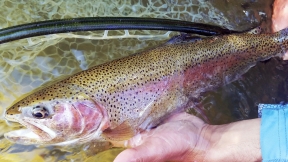
Things look grim for our water situation. Currently the Henry’s Fork Basin water year precipitation has fallen to 86% of average and the snow water equivalent is 74% of average. This wouldn’t be so serious if we weren’t coming off from a poor water year in 2021. All of the reservoirs were completely full at the start of the 2021 season. That may not be the case this year. Things can change significantly over the next three months but we’ll need substantial help from Mother Nature. Our predictions and forecast are based on the current data available. We’ll provide updates over the next few months so be sure to keep checking in on our website and social media. We have current information on water on our Home Page.
Henry's Fork
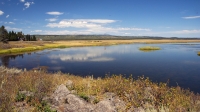
We anticipate an early season. Some of the best fishing will likely get started in March with superb midge fishing. April should produce exceptional fishing with Blue Winged Olive and March Brown mayflies along with Mother’s Day Caddis. Look for the salmonfly hatch to get going on the lower river about the middle of May. Look for PMDs in early June followed by Green Drakes and, in the Harriman Ranch, Brown Drakes. Irrigation demand will likely bring higher stream flows by the time the Ranch opens on June 15th.
Last year, Drunella flavilinea, commonly called “Flav” produced some of the best dry fly fishing of the season. Hopefully this season will follow suit. The Flav hatch should be rolling along by the last week of June. July will be a bit more challenging with higher than normal stream flows expected from the Island Park Dam. High flows will likely continue through mid-August when irrigation demand decreases. Like last season, we expect terrestrial insects like hoppers, ants and beetles to be top fare through August and early September.
If our summer ends up dry and hot, higher stream flows can help keep water temperatures cooler and stable. In the past Idaho has not implemented “Hoot Owl” restrictions resulting from high water temperatures. To sum things up we expect excellent fishing on the Henry’s Fork from mid-March through the middle of July. After that it might be better to focus on some of the other rivers until the nights cool off and irrigation demand is reduced later in the summer.
Madison River
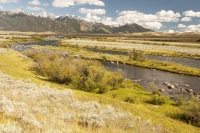
Last year the Madison fished great from mid-June until later in July. Like the Henry’s Fork, the flow is controlled by a dam. By late August last year the lake was as low as we’ve seen in a long time. Almost all of the boat accesses were high and dry. Stream flow from the Hebgen Dam was near normal until about the 20th of August when it dropped below normal and stayed there through the end of the year. Water temperatures became a problem. From the latter part of July through the middle of August maximum temperatures exceeded 68F at the peak of the day. The result was the Montana Department of Fish, Wildlife and Parks implemented “Hoot Owl” regulations which restricted fishing from to early morning until 2 pm.
On November 30th something went haywire at the Hebgen Dam. Over the course of the next two days the flow at the Kirby Ranch dropped from 770 cfs to 400 cfs. Normal for the period is 1000 cfs. The drop in flow dried up some of the smaller side channels. Four days later the flow was back to normal. Only time will tell what impact this had on the trout population.
With these factors in mind, the best fishing should occur from the middle part of June through July. After that it will depend on the weather and the stream flows. Last year the salmonfly hatch was very good extending from mid-June until the first of July. July produced good hatches of caddisflies in the evening hours. We can expect the same this year.
Teton River
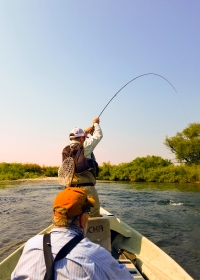
The Teton is a smaller river and one of the only rivers in our system that is free flowing without a dam. The water comes from the snowpack in the Teton Range and from numerous springs. The effect of the drought in 2021 on the Teton was substantial. The average flow during the summer months was only half of normal. This produced exceptional fishing in June when the upper river is normally unfishable due to runoff.
The flow from the Teton Slide through the canyon was too low to navigate after the middle of July. Our most popular float stretch from the old dam down to Hog Hollow fished very well throughout the season even though it was considerably lower than normal. The same can be said for the lower sections below Wilford.
If our current conditions persist I expect the Teton to fish great from June through early July but we could see a drop off later in the season until cool nights in September drop the water temperature. One advantage is that once the runoff is over, virtually all of the water that makes up the Teton is spring-fed. The Teton is a great compliment to the Madison and Henry’s Fork.
South Fork of the Snake
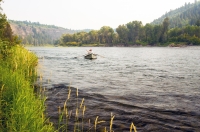
The South Fork is the largest tailwater in the region. Conditions vary according to reservoir storage and stream-flow from the Palisades Dam. The capacity of Palisades Reservoir is 1.2 million acre feet. That seems like a lot of water but the reservoir got down to 200,000 acre feet by the first of October. As of this date the volume is 370,000 acre feet compared to an average of 750,000 acre feet on the first of March.
Normally when Palisades Reservoir is full during spring run-off, the result can produce very high water through June and sometimes early July. That was not the case in 2021. The discharge was average from early-June until the first of July when the flow ramped up above normal to meet irrigation demand. The result was some of the best fishing we’ve experienced in a long time with the salmonfly hatch. The hatch was intense from the end of June through the first weeks of July. Other stoneflies like Golden Stones and Yellow Sallies produced great dry fly fishing.
Fishing the banks with chubbys and hoppers was very good after the stream flows came up in mid-July. Riffle fishing later in the summer was not as productive. This was likely due to above average flows. All in all the South Fork was very good last year and we expect the same this year, at least until later summer.
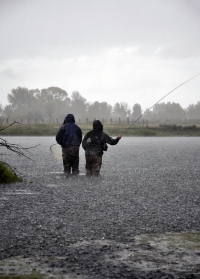
We’ll provide an update at least once a month until we know where we stand with water conditions. Three factors that have great influence on our fishing are:
1) Snowpack. We need a normal to above normal snowpack to insure that our reservoirs fill and stream-flow can be managed.
2) Spring weather. Even if we have above normal snowpack above normal temperatures in March and April will melt the snow too early which can result in water shortages later in the summer.
3) Timely moisture. Even if we don’t get the snowpack we need or optimum spring-time temperatures, timely rain can help off-set the other factors. The worst case scenario is when we have below normal snowpack, below normal reservoir capacity and prolonged hot, dry weather.
Even though 2021 was one of driest, hottest on record we still had exceptional fishing throughout the season. Hopefully it will be the same this season.